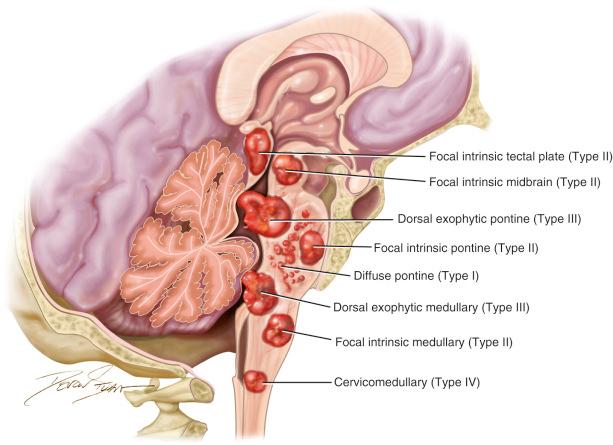Physical Address
304 North Cardinal St.
Dorchester Center, MA 02124
In general, surgical resection is preferred for accessible, symptomatic lesions with a focal growth pattern, while stereotactic biopsy is typically reserved for tumors with a diffuse growth pattern.
If obstructive hydrocephalus is present, it is treated with a CSF diversion technique. In pediatric cases, and selective adult cases, an endoscopic third ventriculostomy (ETV) is preferred over ventriculoperitoneal shunt (VPS) placement.
Diffuse pontine glioma (brain biopsy is also controversial).
Lesions that are clinical and radiologically stable may be initially managed in a non-operative manner with serial imaging. Surgery is performed in cases of tumor progression/new contrast enhancement on MRI or development of obstructive hydrocephalus (third ventriculostomy and/or decompression).
Because most midbrain lesions have an indolent course, some surgeons discourage open resections for these lesions.
Brainstem tumors account for 10–20% of pediatric and 1.5–2.5% of adult intracranial tumors.
Brainstem gliomas are the most common pathologic entity.
Pathologies include gliomas, metastatic tumors, cavernous malformations, hemangioblastomas, demyelinating processes, infectious processes, granulomas, infarction or hematomas.
Classification of brainstem lesions is based on CT and MRI ( ) ( Figure 5.1 ):
Type I: diffuse.
Type II: focal intrinsic.
Type III: focal exophytic.
Type IV: cervicomedullary.

Growth pattern, location and the presence of hydrocephalus or hematoma modifies the surgical management of the lesion.
Preoperative imaging studies:
MRI: Non-contrast enhancement, focal and well-circumscribed exophytic lesions are low-grade features. Contrast enhancement may be indicative of a higher-grade lesion for both focal or diffuse lesions.
PET (positron emission tomography): Used in the attempt to differentiate low-grade from high-grade gliomas.
DTI (diffusion tensor imaging): Can elucidate the relationship of motor and sensory tracts to the brainstem lesion. Current uses are limited.
Preoperative planning: Careful study of the preoperative imaging is required to select the most suitable approach in order to avoid major neurovascular structures, white matter tracts and brainstem nuclei.
Location: Brainstem gliomas located in the midbrain and medulla are usually focal and low grade. Gliomas located in the pons usually have an infiltrative and more aggressive nature. Obstructive hydrocephalus is common in midbrain and dorsally exophytic tumors.
The management of diffuse tumors is controversial. At present, it is still acceptable to initiate standard, non-surgical therapy without pathological confirmation. Brainstem biopsy is not that common because of the risk of permanent damage to eloquent structures. However, with the improvement of surgical techniques and preoperative planning, the management is trending towards performing a biopsy for diagnosis and molecular characterization followed by adjuvant therapies if required.
Become a Clinical Tree membership for Full access and enjoy Unlimited articles
If you are a member. Log in here